Russellville, Arkansas
Russellville is the county seat and largest city in Pope County, Arkansas, United States, with a 2021 estimated population of 29,338. It is home to Arkansas Tech University. Arkansas Nuclear One, Arkansas' only nuclear power plant is nearby. Russellville borders Lake Dardanelle and the Arkansas River.
Russellville, Arkansas | |
|---|---|
| City of Russellville | |
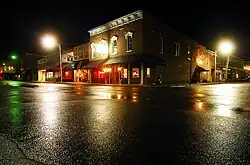 | |
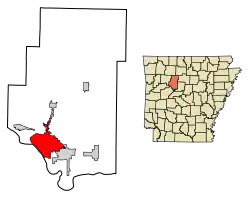 Location of Russellville in Pope County, Arkansas. | |
 Russellville Location within the contiguous United States of America | |
| Coordinates: 35°16′34″N 93°08′18″W | |
| Country | |
| State | |
| County | Pope |
| Townships | Dover, Galla, Illinois |
| Incorporated | June 7, 1870 |
| Named for | Dr. Thomas Russell |
| Government | |
| • Mayor | Fred Teague (I) |
| • Council | Russellville City Council |
| Area | |
| • City | 28.37 sq mi (73.47 km2) |
| • Land | 28.30 sq mi (73.30 km2) |
| • Water | 0.06 sq mi (0.17 km2) |
| Elevation | 367 ft (112 m) |
| Population (2020) | |
| • City | 28,940 |
| • Density | 1,022.54/sq mi (394.80/km2) |
| • Metro | 86,666 |
| Time zone | UTC-6 (Central (CST)) |
| • Summer (DST) | UTC-5 (CDT) |
| ZIP code | 72801, 72802, 72837, 72858 |
| Area code | 479 |
| FIPS code | 05-61670 |
| GNIS feature ID | 2404658[3] |
| Major airport | LIT |
| Website | russellvillearkansas |
It is the principal city of the Russellville Micropolitan Statistical Area, which includes all of Pope and Yell counties. Under Arkansas Code Title 14, Russellville is a city of the first class.[4]
History
Settlement
Before the town was named Russellville, its vicinity was known as Chactas Prairie, The Prairie, or Cactus Flats.[5] Located on the southern edge of the Ozark Mountains and north of the Arkansas River, this setting was an ideal settlement area.[6]
In the early 19th century, Osage from Missouri hunted frequently in the valley where Russellville is now located. Between 1818 and 1828, the area was within a Cherokee reservation. Under a new treaty concluded on May 6, 1828, the western boundary of Arkansas was established, with seven million acres west of Arkansas in Indian Territory (present-day Oklahoma) provided to the Cherokees "forever." The Cherokees agreed to leave the Arkansas lands within 14 months.[7]
The first house in what is now Russellville, a one-and-a-half-story hand-hewn log house, was built by J.C. Holledger in 1834 and purchased the next year by Dr. Thomas Russell.[8][9] One of the first businesses to be established in the town was a store opened in the 1840s by brothers James Madison and Benjamin "B.D.R." Shinn. In 1852, with a cash capital of $500, Benjamin's son, Jacob Shinn established one of the first general stores—just down the road from the log home of Thomas Russell—in an 18 ft by 24 ft building.[10] Shinn replaced the wood structure store with a masonry structure, a building completed in 1876 and which, still standing today, is known as the Shinn Building.[11] It was built at the junction of an east–west road from Lewisburg to Clarksville and a north–south road between Dover and the military road crossing at Norristown on the Arkansas River.[12] The intersection is now Main Street and Denver (formerly River) Street respectively. Before the construction of the masonry building, the existing store was moved to the back of Shinn's property and, during construction, continued in operation.
Antebellum Period
According to tradition, in the 1840s, the choice of a name for the community of five homes and a store was between Russellville—for Thomas Russell, who had the first home in the area and was a doctor—and Shinnville—for Jacob L. Shinn who established the community's first store.[13][14] However, Russellville was actually named about 1842 when Jacob was a teen.[15] Russellville is listed on mail routes in requests for proposals for carrying the mail in 1842,[16] when Shinn was 15, and in 1846, when he was 19,[17] so naming the community after Jacob would have been quite unlikely. However, in the 1840s, his uncle, James Madison Shinn, and father, B. D. R. Shinn, operated a store in the small frontier community, so any truth in the naming tradition may apply to them.[18]
A post office was established as early as the early 1840s based on request for mail route proposals and certainly by 1854.[19]
American Civil War
As with the war with Mexico in the 1840s, many men of Russellville served in the state's military forces during the American Civil War. Local men served in the state forces early in the war, with many transferring to Confederate regiments by 1862. Several local men were also formed into at least two pro-Union companies. No great battles occurred in or near Russellville, though actions did take place late in the war at nearby Dardanelle (Yell County). While the war came to an official end in 1865, peace did not immediately return to the area. Many areas of Pope County were disrupted in the early 1870s by the turmoil of what came to be known as the Pope County Militia War.
Reconstruction era
The town grew slowly, but during the early 1870s the railroad was built and the town exploded commercially and experienced a boom in population. It connected Russellville to other towns in the area, and ran eventually from Ft. Smith to Little Rock, connecting other river valley towns such as Morrilton, Conway, Atkins, London, and facilitating trade among them. Russellville's first newspaper, the Herald, was founded in 1870. By 1876, the town boasted a population of approximately 800 serviced by fifteen stores, two cotton gins, and six doctors.
Incorporation as a city
On June 7, 1870, Russellville became an incorporated city.[20] Incorporation prompted a debate on moving the county seat, located in Dover since 1841, to one of two growing business centers adjacent to the new tracks. An act to move the county seat passed in the General Assembly in 1873[21] but was repealed during a special session of the General Assembly in 1874.[22] On March 19, 1887, an election was held on whether to move the county seat to Russellville or to Atkins. Russellville was selected by a margin of 128 votes out of 2,670 total votes cast.[23] The question on moving the county seat had also gone to the voters nearly a decade earlier on September 2, 1878, but the results were overturned in the courts.[24]
While formal education came to the Russellville area early with the founding of nearby Dwight Mission in 1820, most early schools were either private or by subscription. The Russellville Public School District was formed in 1870, the year the city was incorporated. By 1876, it had evolved into a nine-month school. By 1890, approximately 400 students attended in ten grades, and in 1893, the first class to attend through twelve grades graduated.
Most 19th-century residents of the area farmed for a living or, with the coming of the railroad, harvested timber. By the end of the century, Russellville and the surrounding area had become a prosperous coal-mining area, with the Ouita Coal Company being the first established. Other coal companies followed with deep mine shafts sunk north and south of town, which, by the 1950s, had given way to strip mining. Cotton became a profitable crop near Russellville; in the early 20th century, bales were sold from wagons in the middle of Main Street. Today, no coal is mined, and the cotton gins are gone.
20th century

In 1906 the town suffered a massive fire in its central business district. The fire consumed nearly half of the buildings but they were quickly rebuilt, most within six months after the fire.[25]
What today is Arkansas Tech University (ATU) in Russellville was established in 1910 as the Second District Agricultural school—a four-year high school. The school evolved over the years, adding 2 years of college courses in the 1920s and dropping the high school courses at the end of the 1929-1930 academic year with the school's name changed to Arkansas Polytechnic College in 1925.[26] Its name was changed to Arkansas Tech University in 1976.
With America's entry into World War II, many Russellville men enlisted or were drafted into the military. Many of the local men served in the 153rd Infantry. Battery D and Battery F of the 206th Coast Artillery Regiment of the Arkansas National Guard were initially stationed at ATU. Many of the men saw service in Alaska in what is known as the Williwaw War.
After the war, the construction of Interstate 40 in 1956 sparked Russelville's growth. The highway has been a boon to the area's growth, much like the railroad was in the 1870s. A major economic boost came as a result of the completion of a dam near the Arkansas River crossing between Dardanelle and Russellville in 1965. The dam created a lake, which led to the establishment of Lake Dardanelle State Park, a major tourist attraction in the area. The completion of the lock and power dam, a part of the McClellan-Kerr Arkansas River Navigation System, which brings in between $1 and $2 billion in trade to the state each year, has greatly improved the area's business prospects. During the 1970s, the town, like so many other small American towns, witnessed the decentralization of its historic downtown area, due to the advent of large retail outlets such as Wal-Mart. Many of the historic buildings were left to decay or were torn down. Also in the 1970s, Arkansas' only nuclear power plant, Arkansas Nuclear One, was built just outside the city, on Lake Dardanelle. The plant brought more people and jobs to the city.
Geography
Russellville is located at 35°16′42″N 93°8′13″W (35.278429, -93.136820).[27] According to the United States Census Bureau, the city has a total area of 28.3 square miles (73 km2), of which 28.2 square miles (73 km2) is land and 0.04 square miles (0.10 km2) (0.08%) is water. It is located on the Arkansas River.
Climate
The climate in this area is characterized by hot, humid summers and generally mild to cool winters. According to the Köppen Climate Classification system, Russellville has a humid subtropical climate, abbreviated "Cfa" on climate maps.[28]
| Climate data for Russellville Municipal Airport, Arkansas (1991–2020 normals, extremes 1892–present) | |||||||||||||
|---|---|---|---|---|---|---|---|---|---|---|---|---|---|
| Month | Jan | Feb | Mar | Apr | May | Jun | Jul | Aug | Sep | Oct | Nov | Dec | Year |
| Record high °F (°C) | 82 (28) |
89 (32) |
95 (35) |
100 (38) |
100 (38) |
109 (43) |
113 (45) |
115 (46) |
110 (43) |
99 (37) |
88 (31) |
81 (27) |
115 (46) |
| Average high °F (°C) | 50.3 (10.2) |
55.0 (12.8) |
64.3 (17.9) |
72.9 (22.7) |
80.3 (26.8) |
88.2 (31.2) |
92.5 (33.6) |
92.4 (33.6) |
85.6 (29.8) |
74.4 (23.6) |
61.8 (16.6) |
52.2 (11.2) |
72.5 (22.5) |
| Daily mean °F (°C) | 40.0 (4.4) |
44.0 (6.7) |
52.5 (11.4) |
61.0 (16.1) |
69.6 (20.9) |
77.9 (25.5) |
81.8 (27.7) |
81.1 (27.3) |
73.6 (23.1) |
62.1 (16.7) |
50.5 (10.3) |
42.1 (5.6) |
61.4 (16.3) |
| Average low °F (°C) | 29.7 (−1.3) |
33.0 (0.6) |
40.8 (4.9) |
49.1 (9.5) |
59.0 (15.0) |
67.6 (19.8) |
71.1 (21.7) |
69.9 (21.1) |
61.7 (16.5) |
49.8 (9.9) |
39.2 (4.0) |
32.0 (0.0) |
50.2 (10.1) |
| Record low °F (°C) | −11 (−24) |
−15 (−26) |
−7 (−22) |
24 (−4) |
32 (0) |
37 (3) |
49 (9) |
47 (8) |
32 (0) |
23 (−5) |
10 (−12) |
−3 (−19) |
−15 (−26) |
| Average precipitation inches (mm) | 3.20 (81) |
3.10 (79) |
4.37 (111) |
4.83 (123) |
4.67 (119) |
3.35 (85) |
3.45 (88) |
3.51 (89) |
3.02 (77) |
4.06 (103) |
4.60 (117) |
4.25 (108) |
46.41 (1,179) |
| Average precipitation days (≥ 0.01 in) | 7.9 | 9.2 | 11.5 | 10.0 | 12.5 | 8.7 | 9.6 | 8.5 | 8.1 | 9.7 | 8.9 | 9.1 | 113.7 |
| Source: NOAA[29][30] | |||||||||||||
Demographics
| Census | Pop. | Note | %± |
|---|---|---|---|
| 1870 | 240 | — | |
| 1880 | 514 | 114.2% | |
| 1890 | 1,321 | 157.0% | |
| 1900 | 1,832 | 38.7% | |
| 1910 | 2,936 | 60.3% | |
| 1920 | 4,505 | 53.4% | |
| 1930 | 5,628 | 24.9% | |
| 1940 | 5,927 | 5.3% | |
| 1950 | 8,166 | 37.8% | |
| 1960 | 8,921 | 9.2% | |
| 1970 | 11,750 | 31.7% | |
| 1980 | 14,518 | 23.6% | |
| 1990 | 21,260 | 46.4% | |
| 2000 | 23,682 | 11.4% | |
| 2010 | 27,920 | 17.9% | |
| 2020 | 28,940 | 3.7% | |
| U.S. Decennial Census[31] | |||
2020 census
| Race | Number | Percentage |
|---|---|---|
| White (non-Hispanic) | 19,978 | 69.03% |
| Black or African American (non-Hispanic) | 1,787 | 6.17% |
| Native American | 172 | 0.59% |
| Asian | 476 | 1.64% |
| Pacific Islander | 16 | 0.06% |
| Other/Mixed | 1,629 | 5.63% |
| Hispanic or Latino | 4,882 | 16.87% |
As of the 2020 United States census, there were 28,940 people, 10,184 households, and 5,858 families residing in the city.
2010 census
As of the 2010 Census,[33] there were 27,920 people, 10,318 households, and 6,383 families residing in the city. The population density was 987.4 inhabitants per square mile (381.2/km2). There were 11,124 housing units at an average density of 393.4 per square mile (151.9/km2). The racial makeup of the city was 83.2% White, 5.5% Black or African American, 0.7% Native American, 1.6% Asian, 0.0% Pacific Islander, 6.7% from other races, and 2.3% from two or more races. 11.7% of the population were Hispanic or Latino of any race.
There were 10,318 households, out of which 28.9% had children under the age of 18 living with them, 42.3% were married couples living together, 14.4% had a female householder with no husband present, and 38.1% were non-families. 30.1% of all households were made up of individuals, and 10.5% had someone living alone who was 65 years of age or older. The average household size was 2.39 and the average family size was 2.97.
In the city, the population was spread out, with 22.6% under the age of 18, 21.4% from 18 to 24, 23.8% from 25 to 44, 19.9% from 45 to 64, and 12.4% who were 65 years of age or older. The median age was 29.1 years. For every 100 females, there were 95.7 males. For every 100 females age 18 and over, there were 93.8 males.
The median income for a household in the city was $38,234, and the median income for a family was $49,440. Males had a median income of $30,133 versus $19,906 for females. The per capita income for the city was $19,637. About 14.5% of families and 18.8% of the population were below the poverty line, including 25.8% of those under age 18 and 9.1% of those age 65 or over.
Economy
Arkansas corporations Tyson Foods, Inc. and Innovation Industries Elevator Signal Fixtures are among the nearly fifty manufacturing plants employing more than 8,300 people. Overall, there are more than ten divisions of Fortune 500 companies located in Russellville. There is a diverse manufacturing base located in the city including: Frozen dinners, railroad crossties, elevator signal fixtures, parking meters, aluminum foil, graphite electrodes, Microplanes, and aircraft and automotive parts.
Media
Russellville's local newspaper is The Courier, which is published six days a week (every day except Monday).
ABOUT the River Valley magazine, a monthly publication[34] distributed across five counties (Pope, Yell, Johnson, Conway, and Logan) of the Arkansas River Valley region, is based in Russellville.
TV stations that reach Russellville are either from the Little Rock or Fort Smith markets as Russellville is on the "fringe" of both service areas. Russellville receives KFSM-TV (CBS) and KFTA-TV (FOX) from Fort Smith and KARK-TV (NBC) and KATV-TV (ABC) from Little Rock. The farther away from the city center one is, the likelihood becomes greater that one will receive the full package of channels from one market over the other (Fort Smith to the west and Little Rock to the east of town).
Several commercial radio stations serve the city, including KWKK-FM 100.9, KARV-AM 610 and KWXT-AM 1490, all of which are licensed to Russellville. In addition, radio stations KCJC-FM 102.3 and KCAB-AM 980 (both licensed to Dardanelle, AR); KVLD-FM 99.3 (licensed to Atkins, AR); KARV-FM 101.3 (licensed to Ola, AR) and KYEL-FM 105.5 (licensed to Danville, AR) have their studios in Russellville.
There are also two non-commercial radio stations operating in Russellville: KMTC-FM 91.1 and KXRJ-FM 91.9 (the radio station licensed to Arkansas Tech University).
Tourism
Russellville is known for its local music, art scene, and historic downtown area. The most notable of these events is the Art Walk. On the first Friday night of each quarter (March, June, September, and December), the city hosts the Downtown Art Walk, in which the public may listen to live music, taste wine and food, and appreciate, purchase and sell art while connecting with the community, as well as have their picture taken in the Alley.
Russellville hosts a variety of sporting events and fishing tournaments, due to its location on Lake Dardanelle. Russellville is also close to Mt. Nebo and other state parks such as Lake Dardanelle State Park. Also many people commute to Russellville on a daily basis from its surrounding areas, for both work and recreation.
Balloons over Russellville is a hot air balloon festival taking place at the Russellville Soccer Complex the first weekend of May annually since 2012. The event features multiple hot air balloons, helicopter rides, skydiving, live music, vendors, and the Arkansas State Championship Chainsaw Carving Competition.[35][36]
Russellville is also home to the Pope County Fairgrounds, which hosts many events ranging from horse racing to fairs and conventions. At the end of every summer, Russellville is also host to the annual Pope county fair, which features rides, live music, livestock, games, and other forms of entertainment. The county fair attracts more than 50,000 visitors each year.[37]
Education
Russellville is home to Arkansas Tech University, which was founded in 1909 and as of 2014 has 12,003 students.
Russellville is within the Russellville School District, which operates Russellville High School.
Russellville is also home to the Alternative learning center, which is made up of SLC (student learning center), SDC (student detention center), and an adult education center. The SLC program allows failing students to get more individualized attention so that they can catch up with the rest of their classmates or attain their high school diploma. The SDC program serves like an in-school suspension and serves students ranging from middle to high school. The adult learning center allows high school dropouts to come back and obtain their high school diplomas or GEDs.
In popular culture
In 2013, Russellville was chosen as one of the filming locations for the independent Christian film "Cowboys and Jesus". One scene was filmed at Cyclone Stadium, depicting a football game in which locals from the area were invited to attend, appearing as "extras".[38]
Russellville power plant Arkansas Nuclear One was featured in a 2011 episode of Aerial America on the Smithsonian Channel.
Notable people
- American composer Scott Bradley, most known for his works in Tom and Jerry (MGM) cartoons, was from Russellville.[39][40]
- Natalie Canerday, actress (Sling Blade, October Sky, Walk the Line), graduated from Russellville High School.
- Jeff Davis, Democratic United States Senator from Arkansas and the 20th governor of the state, lived in Russellville.[41]
- Trevor Drown, Republican member of the Arkansas House of Representatives for Pope and Van Buren counties since 2015;[42] Libertarian Party nominee for United States Senate in 2010.[43]
- Jelly Gardner, baseball player in the Negro leagues.
- Elizabeth Gracen, crowned Miss America in 1982, is a 1979 graduate of Russellville High School.
- Brooks Hays began his law practice in Russellville with his father before he became a U.S. representative and an advisor to U.S. Presidents John F. Kennedy and Lyndon B. Johnson.
- NFL punter and College All-American Greg Horne graduated from Russellville High School in 1983.
- Gary Johnston, U.S. Army major general and commander of Intelligence and Security Command, was a native of Russellville.
- Andrea Lea, Republican member of the Arkansas House of Representatives from Russellville since 2009; candidate for state auditor in 2014.[44]
- Famed knife maker Jimmy Lile was a Russellville native, best known for his work involving the Rambo film series.
- NFL player and All-Pro selection Eddie Meador graduated RHS in 1955, and played college football at Arkansas Tech University.[45]
- Professional wrestler and reality television star Matt Riviera was born and raised in Russellville.
- Kerry Shook, minister, best-selling author, and Senior Pastor of Woodlands Church in The Woodlands, Texas is a Russellville native.
- Greg Standridge, Republican member of the Arkansas State Senate from Russellville since 2015.[46]
- NBA player Corliss Williamson is a 1992 graduate of Russellville High School.
- United States congressman Steve Womack was born in Russellville. He is a 1975 graduate of Russellville High School and 1979 graduate of Arkansas Tech University.
Gallery
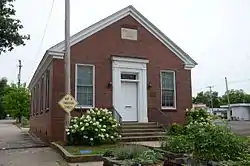 Public Library Annex (Built in 1936-37; image: 30 May 2016 )
Public Library Annex (Built in 1936-37; image: 30 May 2016 )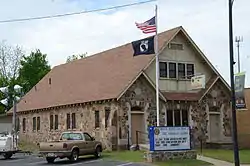 American Legion Hut (Built in 1934; Image: April 18, 2015)
American Legion Hut (Built in 1934; Image: April 18, 2015)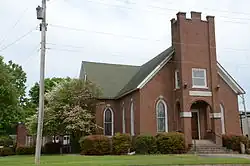 Christian Church (Built in 1885-86; Image: April 18, 2015)
Christian Church (Built in 1885-86; Image: April 18, 2015)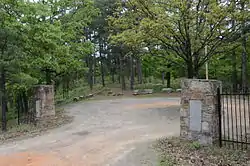 Confederate Mothers Memorial (Donated in 1921; Image: April 18, 2015)
Confederate Mothers Memorial (Donated in 1921; Image: April 18, 2015)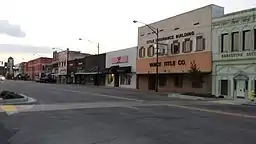 Main Street, August 21, 2013
Main Street, August 21, 2013 Pope County Courthouse (built 1931), August 21, 2013
Pope County Courthouse (built 1931), August 21, 2013
See also
References
- "Russellville". Arkansas Municipal League. 2017. Retrieved March 19, 2017.
- "2020 U.S. Gazetteer Files". United States Census Bureau. Retrieved October 29, 2021.
- U.S. Geological Survey Geographic Names Information System: Russellville, Arkansas
- "2020 Arkansas Code Title 14 - Local Government". Title 14, Act of 2020. Arkansas General Assembly.
- West, D. Porter (1906). D. Porter West's Early history of Pope county; a story. Pope County, Arkansas. p. 9. Retrieved December 30, 2022.
The situation is most beautiful, being a small prairie, dotted all over with nice little groves of trees.
{{cite book}}: CS1 maint: location missing publisher (link) - "Russellville Downtown Historic District". National Park Service, National Register of Historic Places. National Park Service. Retrieved February 16, 2023.
This property is listed in the National Register of Historic Places in accordance with the attached nomination documentation...
- Littlefield, Danel F.; Underhill, Lonnie E. (Summer 1972). "The Cherokee Agency Reserve, 1828-1886". The Arkansas Historical Quarterly. Fayetteville, Little Rock: Arkansas Historical Association. 31 (2): 167–168. doi:10.2307/40022264. JSTOR 40022264. Retrieved February 18, 2023.
The Indians left behind them many well-cultivated farms and substantial dwellings. White settlers moved onto the land and occupied the improvements. Many even purchased the land and improvements from the departing Cherokees, who, of course, had no right to sell them.
- Brown, Walter L. (Winter 1961). "Dr. Thomas Russell: Founder of Russellville". The Arkansas Historical Quarterly. Fayetteville, Little Rock. 20 (4): 389. doi:10.2307/40030659. JSTOR 40030659. Retrieved February 16, 2023.
According to May Russell, the doctor bought the first house on the present site of Russellville. This was a one-and-a-half-story hand-hewn loghouse that stood until 1898 on what is now the corner of Main and Houston Streets. The house was built in 1834 by J. C. Holledger.
- "Thomas Russell, M. D." The Russellville Democrat. No. 22 - 12th Year. Russellville, Arkansas: B. F. Jobe. June 18, 1885. p. 3. Retrieved February 16, 2023.
In search of a new home and a milder climate, he came to Arkansas, and located in the Arkansas River Valley, A. D. 1835, one year prior to the admission of the State into the Union.
- Speer, William S.; Brown, Hon. John Henry, eds. (1881). The Encyclopedia of the New West. Marshall, Texas: The United States Biographical Publishing Company. pp. 155–156. Retrieved June 24, 2023.
- "Our Home Patrons - J. L. Shinn". Russellville Democrat. Russellville Arkansas. December 7, 1876. p. 2.
This building stands over the identical spot where Mr. S. sold his first dollars worth of goods and was finished only last May.
- D. F. Shall (1854). Colton's Railroad & Township Map of Arkansas (Map). J. H. Colton & Co.
- "Russellville Downtown Historic District". National Park Service, National Register of Historic Places. National Park Service. Retrieved February 16, 2023.
It is said that at a town picnic on July 4, 1847, it was decided that the new settlement which consisted of a general store and five houses should be given a name. They determined the name should be either Russellville, after Dr. Thomas Russell, largely because he had the first home with brick chimneys and was a doctor, or Shinnville, after Jacob L. Shinn, who established the first general store in the settlement. The results of the election to name the town were seven votes for Russellville and only five for Shinnville.
- West, D. Porter (1906). D. Porter West's Early history of Pope county; a story. Pope County, Arkansas. p. 9. Retrieved December 30, 2022.
At the close of the war Mr. Jake Shinn returned home in 1847. He had saved his wages and opened up a small store; pointing west opposite to Mr. Hugh Wells. Shortly afterwards a number of neighbors from the settlement of the prairie casually met, and the question of a name for the town arose and the subject was discussed pro and con. Mr. Shinn's friends claimed the name upon the ground of his having the first store, Mr. Russell's for occupying the first house. The vote was taken and the result was the town was named Russellville.
{{cite book}}: CS1 maint: location missing publisher (link) - "Thomas Russell, M. D." The Russellville Democrat. No. 22, 12th year. Russellville, Arkansas: The Democrat Printing Company. June 18, 1885. p. 3. Retrieved March 2, 2023.
About the year 1842, when but a small hamlet, this place was named, by a majority vote of its citizens, Russellville, in honor of Doctor Thomas Russell, who was at the time one of the principal landowners.
- "U. S. Mail Proposals". Arkansas State Gazette. No. 15 Vol. XXIII. Little Rock, Arkansas: William E. Woodruff. March 23, 1842. p. 1. Retrieved February 25, 2023.
Leave Washington every Saturday at 6 a. m., arrive at Russellville every Monday by 6 p.m.... Leave Russellville every Tuesday at 6 a.m., arrive at Washington every Thursday by 6 p.m.
- "Proposals for carrying the mails of the United States". Arkansas True Democrat. No. 22, Vol III. Little Rock, Arkansas: A. H. Rutherford. February 11, 1846. p. 3. Retrieved February 25, 2023.
Leave Camden every other Friday at 6 a. m., arrive at Russellville next Sunday by 6 p.m.... Leave Russellville every other Monday at 6 a.m., arrive at Washington next Wednesday by 6 p.m.
- Speer, William S.; Brown, Hon. John Henry, eds. (1881). The Encyclopedia of the New West. Marshall, Texas: The United States Biographical Publishing Company. pp. 155–156. Retrieved March 16, 2023. Note: The Shinn's youngest son, Charles W., was born in Youngstown, Ohio, in June 1864.
- Baldwin, Thomas; Thomas, J (MD) (1854). A New and Complete Gazeter of the United States. Philadelphia: Lippincott, Grambo & Co. p. 1013. Retrieved February 18, 2023.
- David L., Vance (January 23, 2017). "Russellville (Pope County)". Encyclopedia of Arkansas History & Culture. Central Arkansas Library System. Retrieved March 19, 2017.
- An Act entitled "An act to move the county seat of Pope County." (Acts of the General Assembly of the State of Arkansas (1873) ed.). Little Rock, Arkansas: Little Rock Printing and Publishing Company. April 25, 1873. p. 239. Retrieved December 23, 2022.
- An Act to repeal An Act entitled An act to move the county seat of Pope County (Acts of the Genereral Assembly of the State of Arkansas Passed at the 1874 Special Session ed.). Little Rock, Arkansas: Gazette Book and Job Printing Office. 1874. p. 7. Retrieved December 23, 2022.
- "Election Abstract". The Democrat. Russellville, Arkansas. March 23, 1887. p. 3.
1399 for Russellville, 1271 for Atkins
- "Come, Let us Reason Together". The Democrat. No. 32 Vol. IV. Russellville, Arkansas. August 29, 1878. p. 2.
- "Russellville Downtown Historic District". National Park Service, National Register of Historic Places. National Park Service. Retrieved February 16, 2023.
On the night of January 16, 1906 a fire destroyed nearly half of the downtown business district. The fire included both sides of Commerce Street from Main to "B" Street. Ironically, Russellville had just formed a fire department and ordered fire-fighting equipment, all of which had not arrived. The newly formed fire department, insufficiently organized, was helpless to contain the ravaging fire which, fueled by strong winds, spread to the north side of Main Street from Commerce. In less than three hours, twenty-three buildings were destroyed. The estimated loss was $250,000 of which only 40% was insured. In addition to the loss of the buildings and their stock, many of the citizens of Russellville who worked in the businesses abruptly lost their jobs. Those early businessmen of Russellville immediately set about re-building the downtown and, remarkably, within six months, twenty of the twenty-three buildings lost in the fire had been rebuilt." "As a result of the disastrous fire and the determination of the city's businessmen to rebuild, in less than two years Russellville emerged from the disaster a larger and stronger city with blocks lined with new brick business buildings.
- Silva, Rachel (2009). "Arkansas Listings in the National Register of Historic Places: One Hundred Years of Arkansas Tech University". The Arkansas Historical Quarterly. 68 (4): 442–450. JSTOR 40543604. Retrieved November 14, 2022.
A board of trustees for the Second District Agricultural School had been appointed by September 1909 and tasked with finding a location for the school as well as the construction of school buildings, hiring of staff, and development of curriculum. In order to be considered as a site for the school, towns had to pledge at least $40,000 and 200 acres. Fort Smith, Morrilton, Ozark, and Russellville all submitted bids. Russellville's bid included $40,000, 220 acres, and free electricity and water for three years, and on February 10, 1910, the trustees announced that the Second District Agricultural School would be located there.
- "US Gazetteer files: 2010, 2000, and 1990". United States Census Bureau. February 12, 2011. Retrieved April 23, 2011.
- "Russellville, Arkansas Köppen Climate Classification (Weatherbase)". Weatherbase. Retrieved May 17, 2020.
- "NowData – NOAA Online Weather Data". National Oceanic and Atmospheric Administration. Retrieved June 19, 2021.
- "Station: Russellville Muni AP, AR". U.S. Climate Normals 2020: U.S. Monthly Climate Normals (1991-2020). National Oceanic and Atmospheric Administration. Retrieved June 19, 2021.
- "Census of Population and Housing". Census.gov. Retrieved June 4, 2015.
- "Explore Census Data". data.census.gov. Retrieved January 1, 2022.
- "U.S. Census website". United States Census Bureau. Retrieved January 31, 2008.
- aboutrvmag.com
- "Balloons over Russellville - Russellville AR United States - HotAirBalloon.com". www.hotairballoon.com. Retrieved July 29, 2023.
- "Balloons over Russellville 2023 in Arkansas - Dates". rove.me. May 5, 2023. Retrieved July 29, 2023.
- "Home". popecountyfairarkansas.com.
- Russellville football to play role in upcoming inspirational film
- "Scott Bradley", ..Tom and Jerry Online.
- "Scott Bradley (I) (1891–1977)", IMDb.
- "Arkansas Governor Jefferson Davis". National Governors Association. Retrieved August 17, 2012.
- "R. Trevor Drown". arkansashouse.org. Retrieved April 8, 2015.
- "Trevor Drown". Project Vote Smart. Retrieved April 8, 2015.
- "Max Brantley, Andrea Lea joins GOP race for state auditor, July 2, 2013". Arkansas Times. Retrieved January 1, 2014.
- "Home". edmeador21.com.
- "Greg Standridge's Biography". Project Vote Smart. Retrieved April 17, 2015.
External links
- Main Street Russellville at Main Street Russellville, Inc.
- Russellville Public Library at the Pope County Library System
